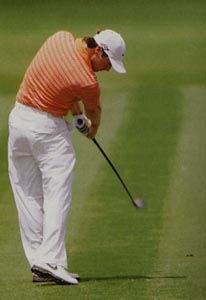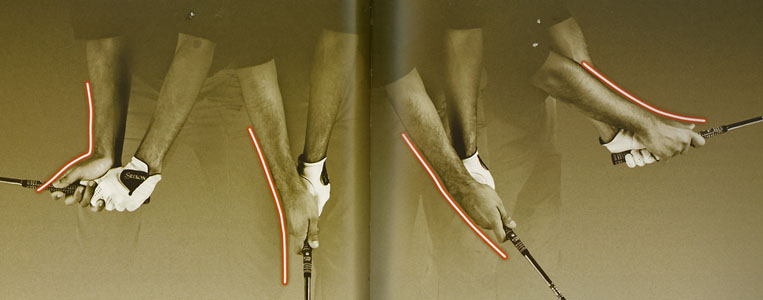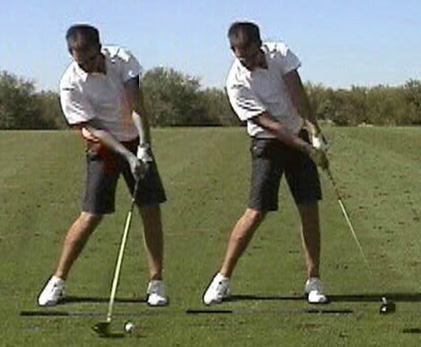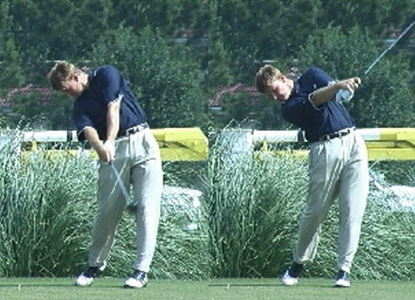Re: your thoughts on TGM i.e homer keller, acumulators ect.
Brian
You wrote-: "I prefer the concept of using both arms to move the club through impact, the left as the steering arm and the right as the power source."
We obviously disagree. In a swinger's action, I believe that the left arm is the power source - via the release of power accumulator #4. I also believe that the right arm is the steering arm - via PP#3 tracing the straight plane line (as described in my review paper).
I don't mind if other golfers, like you, have a different opinion than me. I simply find Homer Kelley's TGM-description of how a golfer (who is a swinger) should power the golf swing very convincing.
I also think that there is nothing about Homer Kelley's power loading/release actions that implies that the swing is two-dimensional. The clubshaft is released on the inclined plane of the swing, which means that the clubshaft is moving three-dimensionally - down-and-out-and-forwards. The arm movement is also a three-dimensional movement, but the arms do not move on the surface of the inclined plane.
You wrote-: "The power and speed does not come solely from the unhinging action, most of it is produced as the clubface is rotated from an open position to a closed one."
Homer Kelley discussed that clubface roll-over action in his power accumulator model - it is the release of power accumulator #3, which occurs after the release of power accumulator #4 (the master PA) and power acumulator #2 (the velocity PA). Power accumulator #3 is called the transfer PA, because it transfers the power from the velocity PA to the ball. The power accumulator release sequence in a swinger is 4:2:3.
Bill - Homer Kelley does discuss the issue of what you incorrectly call the "true" impact point. The "true" impact point is when ball-clubface collision occurs, and not 3" after ball impact. HK states that the endpoint for power accumulator release is when both arms are fully straight - and that happens when the clubhead reaches the low point of the clubhead arc (which is the deepest part of the divot post-ball impact). The low point is usually opposite the left shoulder and it is a few inches ahead of the ball (but the precise amount in inches depends on where one places the ball relative to the low point of one's clubhead arc).
Jeff.
Brian
You wrote-: "I prefer the concept of using both arms to move the club through impact, the left as the steering arm and the right as the power source."
We obviously disagree. In a swinger's action, I believe that the left arm is the power source - via the release of power accumulator #4. I also believe that the right arm is the steering arm - via PP#3 tracing the straight plane line (as described in my review paper).
I don't mind if other golfers, like you, have a different opinion than me. I simply find Homer Kelley's TGM-description of how a golfer (who is a swinger) should power the golf swing very convincing.
I also think that there is nothing about Homer Kelley's power loading/release actions that implies that the swing is two-dimensional. The clubshaft is released on the inclined plane of the swing, which means that the clubshaft is moving three-dimensionally - down-and-out-and-forwards. The arm movement is also a three-dimensional movement, but the arms do not move on the surface of the inclined plane.
You wrote-: "The power and speed does not come solely from the unhinging action, most of it is produced as the clubface is rotated from an open position to a closed one."
Homer Kelley discussed that clubface roll-over action in his power accumulator model - it is the release of power accumulator #3, which occurs after the release of power accumulator #4 (the master PA) and power acumulator #2 (the velocity PA). Power accumulator #3 is called the transfer PA, because it transfers the power from the velocity PA to the ball. The power accumulator release sequence in a swinger is 4:2:3.
Bill - Homer Kelley does discuss the issue of what you incorrectly call the "true" impact point. The "true" impact point is when ball-clubface collision occurs, and not 3" after ball impact. HK states that the endpoint for power accumulator release is when both arms are fully straight - and that happens when the clubhead reaches the low point of the clubhead arc (which is the deepest part of the divot post-ball impact). The low point is usually opposite the left shoulder and it is a few inches ahead of the ball (but the precise amount in inches depends on where one places the ball relative to the low point of one's clubhead arc).
Jeff.








Comment